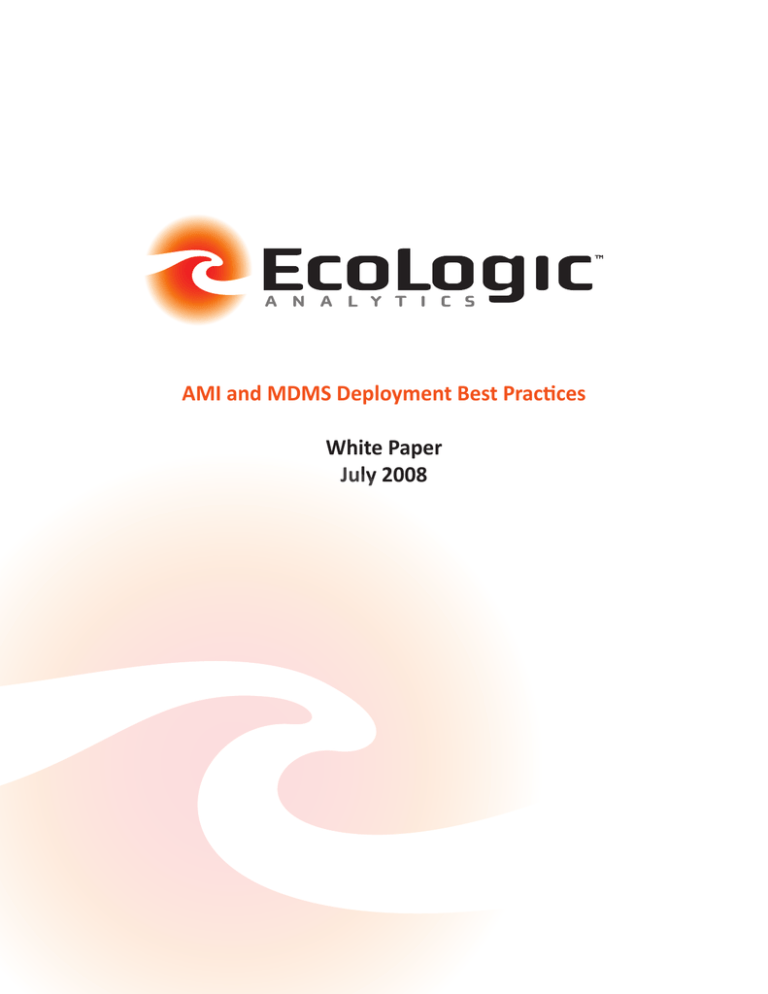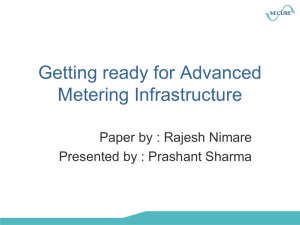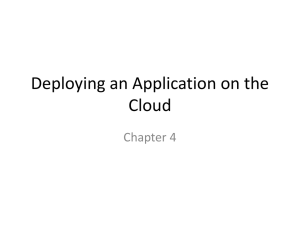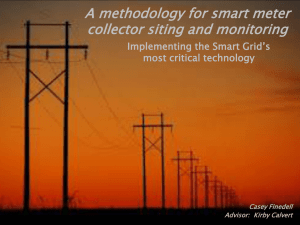AMI and MDMS Deployment Best Practices White Paper July 2008
advertisement

AMI and MDMS Deployment Best Practices White Paper July 2008 -1- AMI Deployments: Lessons Learned The move to advanced metering capabilities is upon us. More and more cities and utilities desire the ability to not only streamline the collection of meter data, but use the information for advanced applications and business intelligence. In fact, according to Chartwell’s 2006 annual report, of the 73 utilities interviewed nearly three-quarters said they were considering using advanced metering infrastructure (AMI) for residential programs that use time-of-use (TOU) rates. Even without defining specific programs by type, i.e. TOU, critical peak pricing (CPP) and real-time pricing, more than half of the respondents said they are looking to use future or existing AMI systems for load control or demand response programs. As applications such as demand response and dynamic pricing come online, a true two-way communication with the each meter will be required. This can be achieved by implementing AMI systems, including meters commonly referred to as “smart meters.” AMI and Home Area Networks (HAN) essentially create end-users at each service point, providing opportunities for utilities to interact directly with their customers through the meter and in-home devices. Is the IT organization impacted by AMI? Absolutely. With an AMI deployment, the scope of the IT organization extends beyond the traditional data center and the operations that it manages and out into the utility’s service territory. The IT organization must work closely with the AMI meter vendors to ensure that communications from meter to the data center systems—such as the AMI head-end systems and meter data management system (MDMS)— are managed properly. It is critical that all meter data be collected in a timely (near-real time or continuous) manner to gain the maximum benefits of AMI. Additionally, the amount of data and the type of processing are radically different from what a utility has traditionally done with applications like mobile automated meter reading (AMR) systems. A mobile AMR system may collect meter data once a month, primarily to produce a monthly bill. With AMI, meter data will likely be collected several times throughout the day and systems will process this meter data that may represent not only daily read data but also interval reads at 60-minute, 30minute, 15-minute, or even 5-minute intervals. This data supports traditional and time-of-use billing as well as advanced applications such as theft detection, load forecasting, demand response, outage management, mobile work force management, customer web presentment and others. Building the technical architecture and systems to support advanced metering capabilities requires that the IT organization prepare for a dramatic increase in the volume of data a new AMI system is capable of bringing into the utility and a shift in the way in which the data is processed. The notion of the traditional batch or nightly processing window is not viable in AMI. Meter data is continuously being collected, processed, and integrated with several applications in the utility’s enterprise. While highperformance, fault tolerance, and disaster recovery objectives are not new to IT, AMI certainly places much more emphasis on them. AMI brings significant added value to a utility and many of its existing or new application systems will be integrated with the AMI data. It is also important to realize that AMI technology and capabilities are advancing and evolving at a rapid pace and a utility should be positioned to take advantage of these advancements. This means it is critical to architect a highly adaptive solution that will allow the deployment of advances in technology and applications without upsetting the entire enterprise solution. If meter data is collected from disparate AMI systems, these systems will each need to be integrated with enterprise application systems to take advantage of the AMI data. With no central data management solution, this integration might look something like the diagram shown in Figure 1. -2- including such systems as: • AMI • MDMS • Customer Information Systems and Billing • Outage Management • Mobile Workflow Management Traditionally, these systems have run somewhat independent of each other, but the shift to AMI will require an enterprise approach, making it important to include each system’s subject matter experts in the project. Implementing an MDMS before or in conjunction with the deployment of AMI will provide great insight, monitoring, validation, presentation, and auditing capabilities for all AMI meter technologies being deployed. The MDMS provides the utility with the ability to monitor the meter data feeds from the AMI systems, providing continuous benchmarking and evaluation of the performance and quality of meter data – not to mention a faster return on investment. Figure 2 depicts the unifying capability the MDMS provides between the AMI and utility systems. It is important that the MDMS be AMI and AMR vendor-agnostic and adaptable in order to streamline meter data collection, processing, persistence, and integration and further, to apply business and regulatory rules in a consistent manner and as required by the utility systems. In order to prepare for an AMI deployment, it is recommended that a pilot program be conducted to prove functional and operational viability and smooth integration across key systems. As an important first step, even prior to launching a pilot program, it is critical to gain agreement across the utility on the implementation plan, and identify subject matter experts for each of the systems of record that will benefit from AMI, Conducting a pilot program with the new AMI technologies and an MDMS with a limited number of meters (e.g. 5,000 meters) is highly recommended. This will allow the utility to test, operate, configure, and gain tremendous exposure to and understanding of the new technologies and systems in an end-to-end integrated environment. AMI technology is relatively young and is making great advances in technology and capabilities. To be positioned for these advances it’s important to plan the technical architecture and application solutions with flexibility and adaptability in mind and to choose a best-in-class— architecture to accommodate changes. -3- Deploying a service-oriented architecture (SOA) to deal with integration challenges and providing a highly-adaptive architecture is recommended. Another best practice, before the full project is commissioned, is to plan for a full performance scalability test to prove operational functionality. For most utilities, it may take a few years to fully deploy AMI meters to their entire service territory. It is important to architect the solution to ensure that it will perform to meet business operational objectives even as the automated meter population grows. Finally, it is important to also consider data storage. Regulatory compliance, archival and disaster recovery are key data storage considerations. The AMI and MDMS systems will revolutionize the way the utility conducts its business and increase its dependence on its data systems. If anything were to happen to the data in the event of a disaster, it will have an increasingly adverse affect on the operation of the utility. Protecting this great asset is a core objective for any data management solution. About the author: Gary is a senior level technical professional with over 20 years of experience in the information systems industry both in corporate IS and consulting services. He is the principal technical architect/DBA and implementation specialist for the development and field consulting organization of Ecologic Analytics, providing technical leadership in the planning, design and building of large-scale implementations. For more information on this topic, Gary can be reached at glutz@ecologicanalytics.com. www.ecologicanalytics.com | contact@ecologicanalytics.com | 952 843 6000 ©2009, Ecologic Analytics, LLC. All Rights Reserved.







